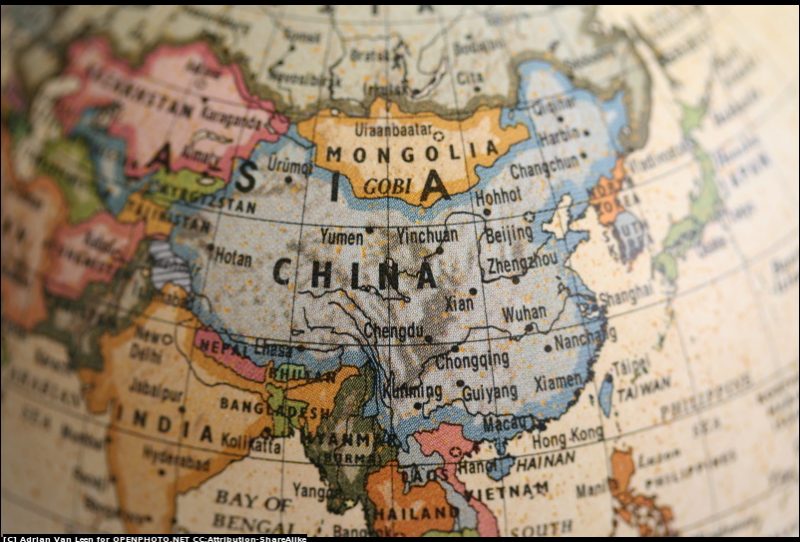
In the 1970s, Saddam Hussein reorganized Iraq into eighteen provinces to divide minority ethnic groups and weaken their ability to challenge the central government. This action is not a historical quirk. Throughout history, politicians have drawn (and redrawn) administrative boundaries within their countries to foster political stability and cement their hold on power, with the reorganization of subnational boundaries in interwar Czechoslovakia and the Roman Empire being other prominent examples.
While gerrymandering in electoral democracies is well-studied, the manipulation of subnational administrative boundaries in all types of political regimes is an equally important but under-researched field.
In our recent study published in Applied Geography, we undertook a rare quantitative study on the creation of subnational boundaries for administrative rather than electoral purposes. Our study sought to understand whether China’s provincial boundaries were designed to foster the unity of the country, and, if so, to identify the locations where the socio-economic consequences of this manipulation likely exist and where remedial action may be necessary.
Our findings suggest that the imperial Chinese state manipulated provincial borders strategically to prevent pivotal provinces along China’s historical North-South political fault line from acquiring the autonomy to challenge its supremacy. The resulting administrative fragmentation of provinces along the Huai River-Qin Mountain line has administrative, environmental, and social consequences which continue to play out today. For example, the lack of information sharing and the tendency of local provincial governments to maximize their own interests at the expense of other provinces leads to uncoordinated efforts to prevent cross-provincial water pollution along the Huai River.
Why do we think that misalignment exists?
China’s river network was both the birthplace of Chinese civilization and the Chinese people’s primary mode of transportation until the early twentieth century. Therefore, physiographic features such as elevation and water flow patterns played a central role in shaping socioeconomic interactions and regional identities within China. However, in Chinese historical scholarly discourse, there exists a longstanding hypothesis that the imperial Chinese state deliberately kept provincial and physiographic boundaries misaligned. Wang Shixing, a Chinese official in the sixteenth century, claimed that the guiding principle was to reduce the autonomy of provinces, while William Skinner, a modern scholar, said that the misalignment aimed to break up natural concentrations of economic power.
This misalignment between provincial and physiographic boundaries can aggravate tensions and coordination failures between upstream and downstream provinces on the same river network, requiring more effort on the part of the central government to coordinate between provinces. However, in areas that are strategic pivots central to the unity of the country, the state may benefit from this administrative inefficiency; by forcing provinces to be reliant on the central government to coordinate inter-provincial issues, provinces are less likely to develop into militarily and economically self-contained geographical units that can declare independence from the rest of the country. In addition, this issue has contemporary relevance. China’s provincial system was first set up in the thirteenth century and the boundaries have been fairly stable since the late seventeenth century, therefore the consequences of historical decisions to misalign provincial boundaries may still have an effect on today’s provinces.
While historians have provided many anecdotal examples to support the misalignment hypothesis, we are not aware of any empirical and quantitative evidence to support the hypothesis. To investigate this issue empirically, we use Geographic Information Systems (GIS) to study this historical question.
How do we measure misalignment?
Our study focuses on the traditional domain populated by the Han Chinese, also known as China proper. To identify if misalignment between provincial and physiographic boundaries exists, we compare the locations of the sixteen modern-day provinces within China proper with the locations of sixteen hypothetical provinces that are drawn based on important physiographic and boundary-drawing principles.
The first set of hypothetical provinces is based on three principles: the integrity of water catchments, the comparability of size between provinces, and the compactness of provinces. These catchment-based hypothetical provinces are informed by the importance of the riverine network for the development of Chinese civilization and by concepts from the electoral gerrymandering literature. To provide an alternative perspective based on a different set of principles and assumptions, we create a second set of hypothetical provinces based on cost distance, which seeks to minimize the cost of overland travel between a provincial capital/hub and its province. Cost distance takes into consideration the actual ground distance and slope inclination traveled, providing a more realistic portrayal of the physical effort required to travel across the province.
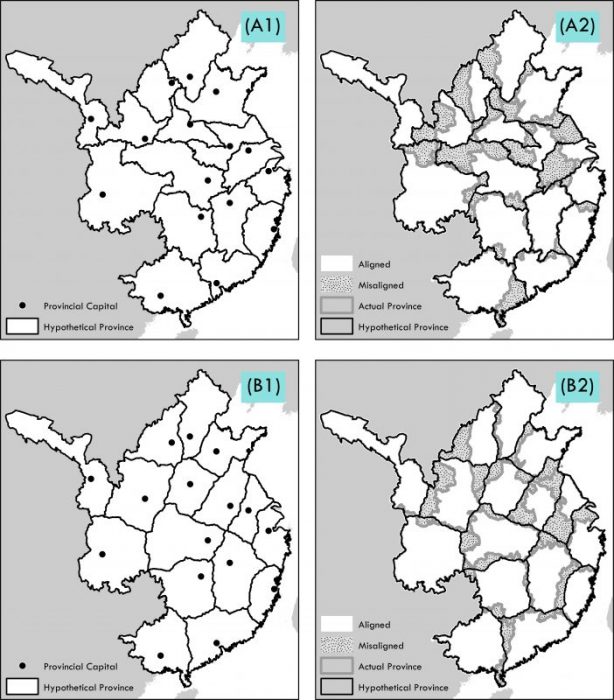
Hypothetical provinces generated by (A) catchment and (B) least cost land distance, which are used as the benchmarks for assessing the misalignment of Chinese provincial boundaries. In A1 and B1, the black solid circles are the provincial hubs. In A2 and B2, the hypothetical provinces are overlapped with the actual provinces to identify the misaligned areas, which are defined as areas where the hypothetical province and the actual province do not share the same hub. Adapted from Sng et al. (2018)
Following that, we construct a congruence index for each province to quantify the degree of congruence between the actual province and its associated hypothetical province. The congruence index is calculated based on the sum of squares of the surface area shares of all hypothetical provinces within an actual province, and the sum of squares of the surface area shares of all actual provinces within a hypothetical province. This congruence index is conceptually similar to the Simpson’s diversity index in ecology and the Herfindhal market concentration index in economics. The lower the congruence index for a province, the more misaligned the provincial and physiographic boundaries are.
What did we find?
The results for both types of hypothetical physiographic provinces show a consistent pattern. The pattern suggests that the sixteen provinces can be classified into a low-score group comprising Anhui, Jiangsu, Shaanxi, Henan, and Shanxi; a mid-score group with Hubei; and a high-score group comprising all remaining provinces.
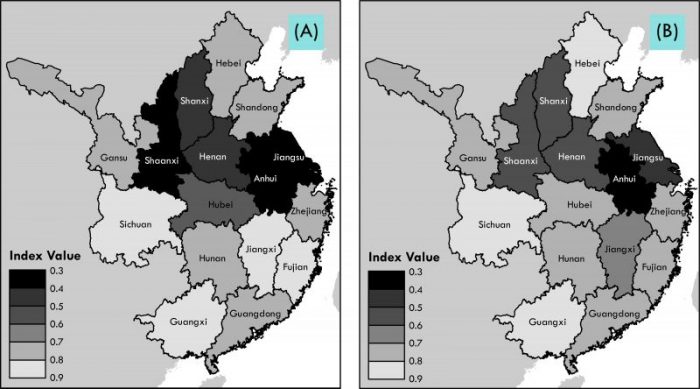
Congruence indices measuring the congruence of Chinese provinces and the hypothetical provinces generated by (A) catchment and (B) least cost land distance. The lower the index value, the more the misalignment between the actual province and its associated hypothetical province. Adapted from Sng et al. (2018)
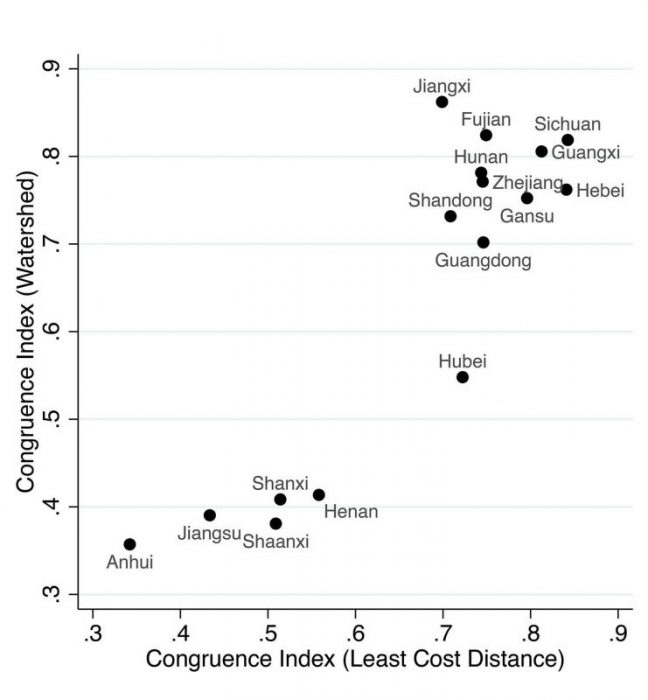
Comparison of congruence index scores, computed using catchment-based and least cost distance-based hypothetical provinces. The index scores for Anhui, Jiangsu, Shaanxi, Shanxi, and Henan are significantly lower than other provinces. Adapted from Sng et al. (2018)
The five provinces with low congruence index scores are located in strategically pivotal regions that played key roles during periods of political disunification. Four of the provinces – Anhui, Jiangsu, Shaanxi, and Henan – are clustered along the Huai River-Qin Mountain line. This line is traditionally perceived as China’s North-South divide because the northern and southern sides of the line differ in terms of climate, ecology, agriculture, and socioeconomic characteristics.
The North-South divide also represents China’s most notable political fault line in history; in the last 2000 years, China experienced only four episodes of prolonged political fragmentation, all of which featured a contest between a regime north of the line and a regime south of the line. Revealingly, instead of using the Huai River-Qin Mountain line as a provincial boundary, the late imperial Chinese state created provinces that stretch across the line so that the provincial boundaries contain no trace of the line. This boundary demarcation also made it difficult for provinces south of the line to resist an invasion from the north, where the central government was located for much of the late imperial period.
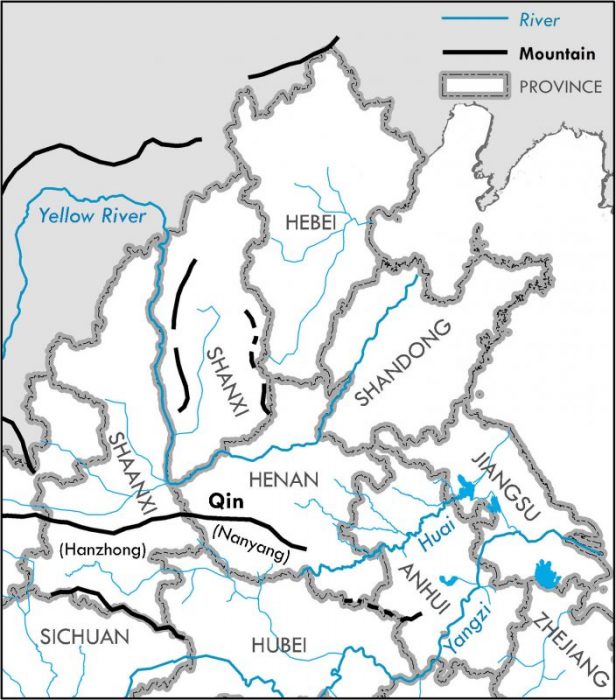
Topographic features of northern and central China. Adapted from Sng et al. (2018)
The fifth low-scoring province, Shanxi, is located between North and Northwest China, which is another traditional political fault line in Chinese history. In contrast, the provincial boundaries of Hunan and Jiangxi — two provinces that have never produced a regime capable of challenging for national supremacy – are defined by the watersheds of the Xiang River and the Gan River respectively.
Misaligned provincial boundaries are costly in terms of economic development and human well-being, and our findings suggest that the provinces along the Huai River-Qin Mountain line are likely to bear these consequences. For example, the administrative fragmentation of the Huai River can complicate disaster response management — during Typhoon Nina (1975), the Henan provincial authorities blew up the Bantai sluice gate to mitigate flooding in Henan, resulting in floodwaters affecting 200,000 acres of agricultural land and 1.5 million people in downstream Anhui.
These findings are described in the article titled Are China’s Provincial Boundaries Misaligned, recently published in the journal Applied Geography. The work was conducted by Tuan-Hwee Sng, Pei Zhi Chia, Chen-Chieh Feng, and Yi-Chen Wang from the National University of Singapore.









